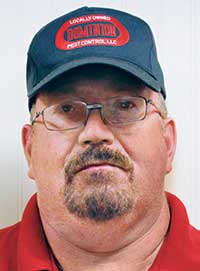Pest management professionals (PMPs) share dos and don’ts to consider when managing cockroaches.
Cockroach management DOs
DO communicate well with the customer. You must be sure they’re willing to modify the roach’s environment by doing a thorough cleaning; otherwise, you might as well pass that customer onto someone else. I would rather let someone else be “the bad guy” by not getting control — and then come in afterward and be the hero.
— Scott Kight, ACE, Fort Myers Pest Control, Fort Myers, Fla.
DO rotate your product baits, liquids and insect growth regulators (IGRs) for all cockroach treatments.
— Jason Rothamel, Pest Control Specialist, Dominion Pest Control, Lancaster, Pa.
DO go above and beyond the norm for the customer by sealing up cracks and crevices with caulk.
— Elliot Zace, Operations Manager, Slug-A-Bug Pest Control, Melbourne, Fla.
DO inspect and identify. We received calls from customers thinking they had a cockroach issue. After our technicians inspected, they often found that the customer had misidentified ground beetles as roaches.
— Jason Rothamel, Pest Control Specialist, Dominion Pest Control, Lancaster, Pa.
DO allow plenty of time for a thorough inspection and treatment. In my years in the industry, I’ve noticed many companies don’t allow the service technician enough time to properly do a German cockroach job, for example.
— Scott Kight, ACE, Fort Myers Pest Control, Fort Myers, Fla.
DO use a vacuum to reduce German cockroach populations. Instant population reduction increases bait availability to remaining cockroaches.
— Scott Robbins, Technical Director, Action Pest Control, Evansville, Ind.
DO perform integrated pest management (IPM): Rotate products, target harborage areas and look beyond where the customer claims to have an issue.
— Elliot Zace, Operations Manager, Slug-A-Bug, Melbourne, Fla.
DO educate the homeowner, tenant and landlord on conducive conditions that will promote future pest problems.
— Jason Rothamel, Pest Control Specialist, Dominion Pest Control, Lancaster, Pa.
DO check behind electrical covers (outlets, etc.).
— Brian Mapes, Owner, Side By Side Pest Control, Arvada, Colo.
DO avoid inadvertent cockroach introduction or re-introduction.
— Dr. Gerald Wegner, retired Technical Director, Varment Guard Environmental Services, Columbus, Ohio
DO remember the ups, downs and ins: Take a ladder to access high harborages, tools for accessing appliance voids, and coveralls or a spare uniform to wear after crawling under kitchen equipment.
— Scott Robbins, Technical Director, Action Pest Control, Evansville, Ind.
DO provide ongoing control, providing the customer with clear expectations and thorough preparation sheets in advance.
— Kevin Mills, Owner, Mills Pest Management, Burbank, Calif.
DO research cockroach behavior and certain barometric pressure in the accounts you manage, because one of the most important aspects of cockroach survival is the very same required by humans: finding shelter, food and water. The value of extensive cockroach knowledge is crucial.
— Thomas Chiarello, Regional Development Manager, Turner Pest Control, Jacksonville, Fla.
DO follow up to ensure what you did actually is working. Don’t wait on the customer to tell you they still have a problem. Make a phone call or institute an automatic follow-up service to check on things.
— Elliot Zace, Operations Manager, Slug-A-Bug, Melbourne, Fla.
DO price and plan for follow-up visits on heavy infestations with challenging sanitation conditions.
— Scott Robbins, Technical Director, Action Pest Control, Evansville, Ind.
DO know your products, their labels, as well as the rate and approved sites or locations where they can be applied.
— Elliot Zace, Operations Manager, Slug-A-Bug, Melbourne, Fla.
DO identify whether it is a German cockroach or something else, and provide written prep instructions specific to German cockroaches.
— Roger Schafer, Owner, A Access Denied Pest Control, Las Vegas
Cockroach management DON’Ts
DON’T neglect bathrooms and bedrooms. For that matter, don’t forget to inspect all areas of the structure. I’ve seen it happen: A technician skips bathrooms and bedrooms because he’s in a hurry or because the customers simply tell him they aren’t seeing roaches in those areas. Don’t just take the customer’s word for it.
— Scott Kight, ACE, Fort Myers Pest Control, Fort Myers, Fla.
DON’T forget that you are the professional and must set the plan of action to quickly eliminate the infestation.
— Thomas Chiarello, Regional Development Manager, Turner Pest Control, Jacksonville, Fla.
DON’T hurry. The more you rush things, the more likely it becomes that you’ll have to keep going back to the account, frustrating both you and the customer. Take your time and do it right.
— Elliot Zace, Operations Manager, Slug-A-Bug, Melbourne, Fla.
DON’T get locked into continually using the same products. Research new products being manufactured. Turn to magazines like PMP and other online industry resources. It’s also crucial to rotate different chemical classes to achieve success.
— Thomas Chiarello, Regional Development Manager, Turner Pest Control, Jacksonville, Fla.
DON’T skimp on insect monitor placements. Proper monitor placement, as well as the ability to decipher what the monitor is telling you, will help detect early activity before it becomes an infestation.
— Scott Robbins, Technical Director, Action Pest Control, Evansville, Ind.
DON’T spray everything. Treat only the harborages the cockroaches are using or could be using.
— Jason Rothamel, Pest Control Specialist, Dominion Pest Control, Lancaster, Pa.
DON’T be sloppy with bait placement, particularly gel baits. Have consideration for the customer’s home and where you apply product. Keep it as discreet as possible.
— Elliot Zace, Operations Manager, Slug-A-Bug, Melbourne, Fla.
DON’T assume all cockroach issues are the same and can be handled in the same manner.
— Sean Candelaria, Operations Manager, Western Exterminator, Los Angeles
DON’T forget to document not only the type of cockroach activity you observe, but also the sanitation and structural issues, which, if not addressed, will make success take longer and make the problem harder to solve.
— Thomas Chiarello, Regional Development Manager, Turner Pest Control, Jacksonville, Fla.
DON’T make the customer feel like they are dirty because they have cockroaches, even if filth or clutter is a factor. There’s a right way to encourage the customer to do the things needed to aid in the resolution of the problem — and there’s a wrong way: shaming them. Approach each account with compassion and consideration. Help in any way you can.
— Elliot Zace, Operations Manager, Slug-A-Bug, Melbourne, Fla.
DON’T assume that you found the entire problem when you find a problem.
— Sean Candelaria, Operations Manager, Western Exterminator, Los Angeles
DON’T only provide an initial service for a cockroach infestation when setting up new accounts, especially new commercial accounts. There should be a minimum of one follow-up service call. Make sure you build the follow-up service in your first month’s pricing.
— Thomas Chiarello, Regional Development Manager, Turner Pest Control, Jacksonville, Fla.
DON’T allow customers to use do-it-yourself (DIY) products between services.
— Jason Rothamel, Pest Control Specialist, Dominion Pest Control, Lancaster, Pa.
DON’T mix liquids and gel baits in the same spot. Keep them separate. Of course, you can use both in the same area, just not on top of each other. Think about what you’re doing, what the products are designed to do, and use common sense.
— Elliot Zace, Operations Manager, Slug-A-Bug, Melbourne, Fla.





Leave A Comment